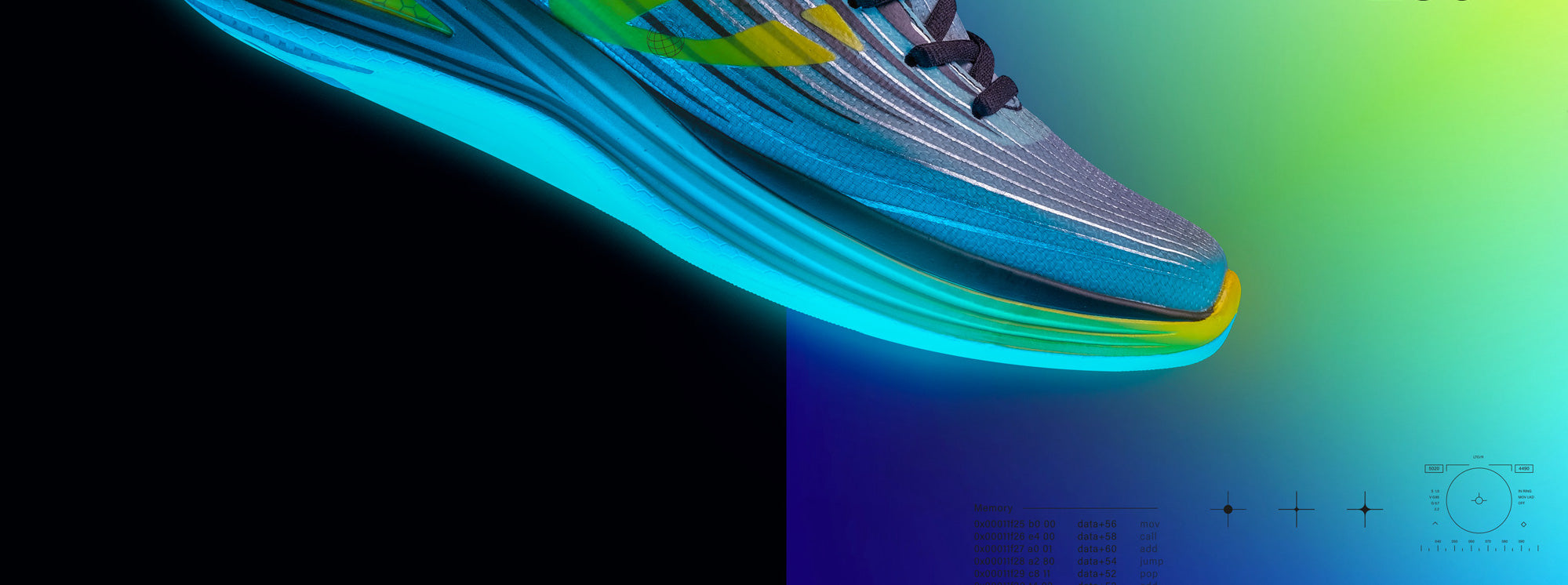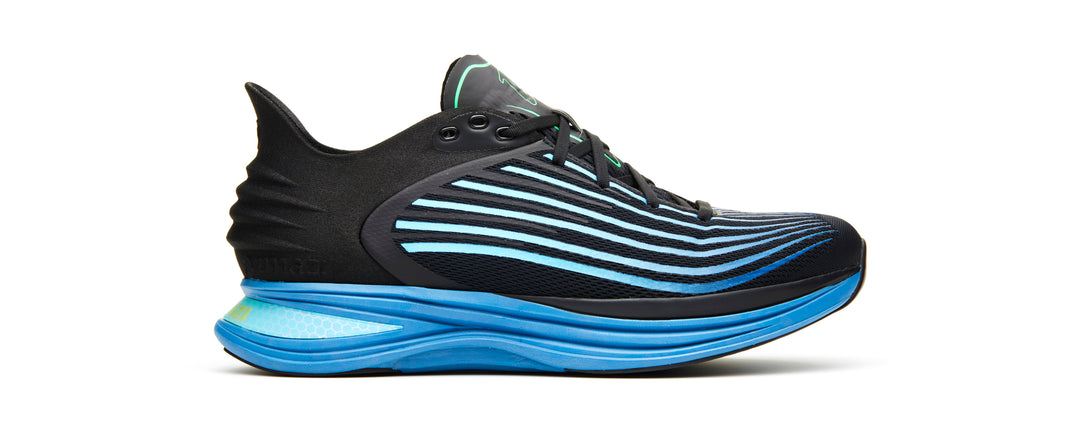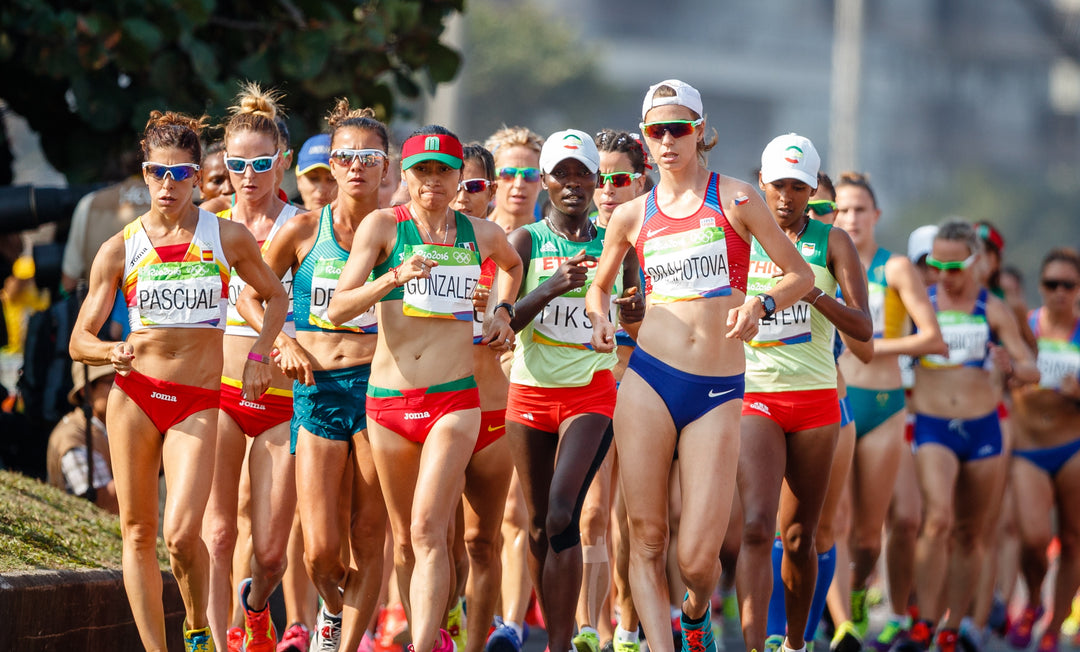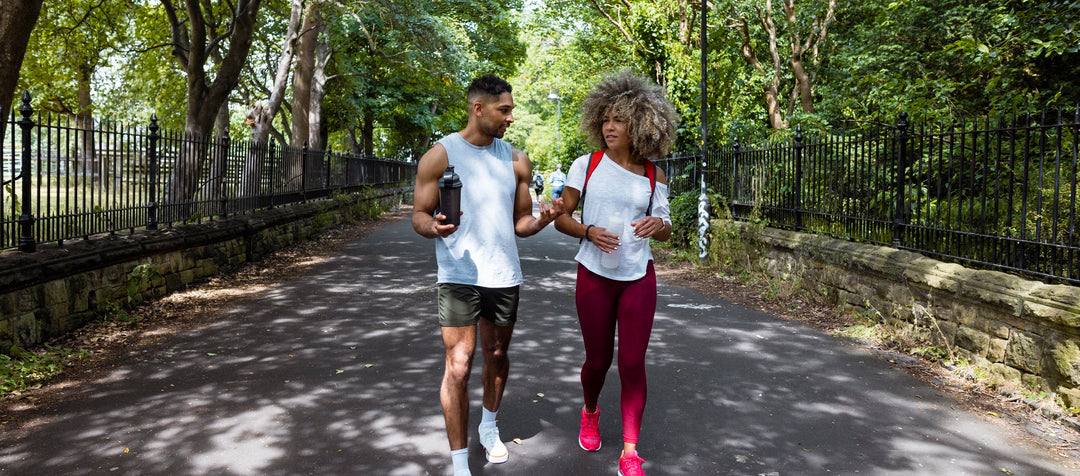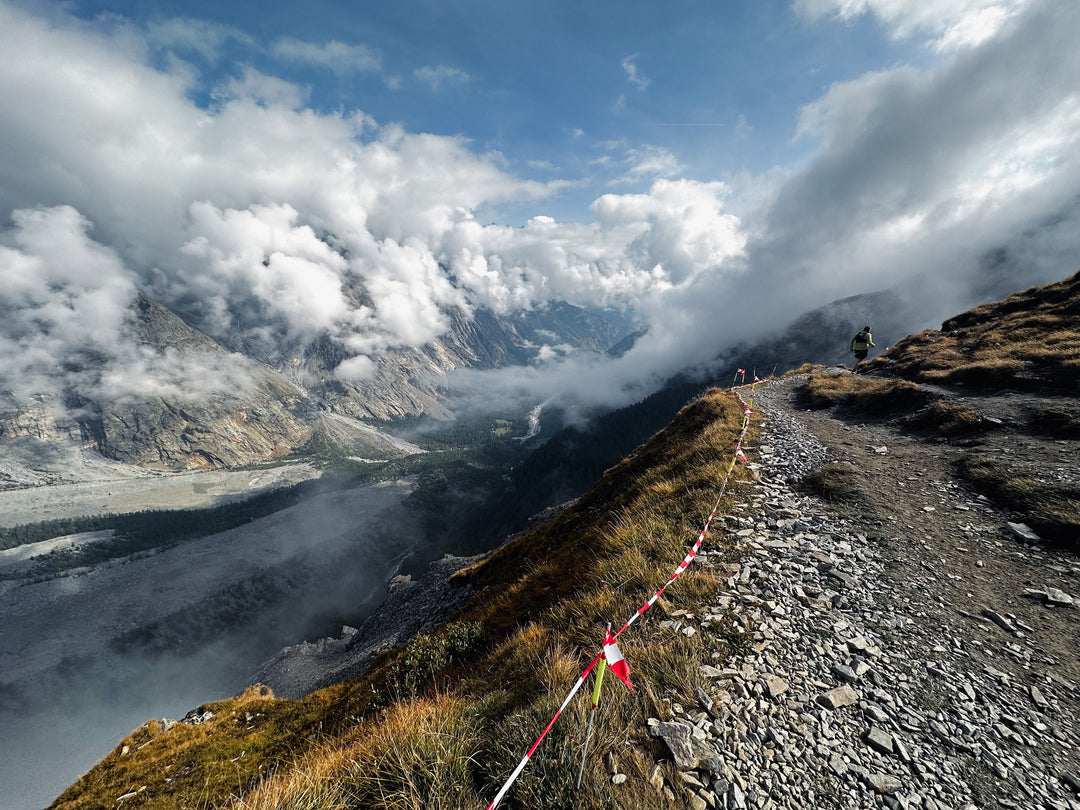One of the current buzzwords in the running industry is supercritical, as in supercritical midsole foams. This refers to a manufacturing process for creating foam midsoles. Nearly every running brand out there touts their use of supercritical nitrogen in the foaming process to make their midsoles more "responsive." I’ll describe what supercritical foam is all about, but the point of this post is to clarify the meaning of the other buzzword: responsive. What do we mean by it, and is it relevant.
Midsole foam is a lot like bread: small bubbles expand inside an elastic matrix (like dough) to make a solid that is much lower density than the original material. When the material cools, a foam structure is permanently set and the bread, unlike a soufflé, keeps its new shape and density. In bread, the chemical bonds in the gluten are much weaker than in shoe materials (fortunately!), and a little moisture and chewing easily breaks them down. The polymers in midsole foams are designed to be the opposite of bread, so they don’t break down, no matter how much moisture and mashing we expose them to.
 Thankfully, we don't run on bread or eat midsoles!
Thankfully, we don't run on bread or eat midsoles!
There are many polymers and combinations of polymers used in manufacturing foams to meet specific performance criteria. The foam in the seat of your car, for example, has a polymer mix different from the foam in the dashboard, different from the foam in the steering wheel. Each application has different requirements for durometer, elasticity, stability to heat, longevity in the presence of ozone, and many many more properties.
The chemical giants specialize in these things. Shoe midsoles are made with polymer mixes that emphasize low density and the ability to rapidly return to an original form after compression. There are many polymer mixes that can achieve the same density, durometer, and elasticity and each chemical supplier has their own branded version. EVA as the base polymer has been popular for the longest time, while in recent decades TPU and PEBA have also become common. At a very granular level, there are definitely differences in the end product depending on the polymer used. The question is, however, are the differences in polymers relevant to running? We’ll come back to that question in a moment.
Supercritical foam is made from the same basic polymers as other foams, but the manufacturing process is different. The process involves nitrogen in a supercritical state. The thing to remember is that nitrogen is the preferred molecule—because it's inert and ubiquitous—but the finished midsole doesn’t actually contain supercritical nitrogen. Unlike replacing CO2 in beer with nitrogen, nobody cares how shoes taste! (If you're curious to learn more about supercriticality, the wiki page is a good primer.)
Back to responsiveness and the question: Is supercritical foam relevant to running? When responsiveness is defined, and usually it isn’t, it’s defined in terms of spring damping. The way it's talked about, the more responsive means less damping. If the foam were shaped into a ball, a more responsive foam would bounce higher when dropped. Of course, if the ball is dropped and not thrown down, it can’t bounce higher than its original starting height. But the closer the ball comes to the original height, the less damping and energy loss occurs during the bounce. In engineering, the ratio of bounce height to initial height is called the quality Q and has a maximum value of 1. So more responsive means higher Q, means less damping. That’s good, right? But the question is, is it relevant?
Answering the question of relevance means diving headfirst into the physics of running. Don’t worry, we can get the gist of it without math. The main thing to remember is that running uses two legs. This seemingly trivial fact is generally ignored in biomechanics, and instead, running is approached as though you can mentally hack the foot off at the ankle, drop it on the ground, and watch it bounce.
But when you think about both legs moving to create a sequence of strides, you can understand how lifting the swing leg generates a force on the ground just as straightening the support leg. Even with a straight and stiff support leg, lifting the swing leg generates a force on the ground. You can also see how the time it takes to create the force is a function of the cadence. A change in cadence means a change in how quickly the swing leg moves forward and up. Of course, the support leg is moving simultaneously—the two legs are joined at the hip—and the two legs move 180 degrees out of phase. The slower the cadence, the longer the time on the ground pushing off.

Contrast the cadence controlled running motion with a material controlled midsole foam. A midsole foam will bounce back in the same amount of time no matter what the runner’s cadence is. This is a physical property of any elastic foam, whether it is made with supercritical nitrogen or with regular air. The point is, the responsiveness of a foam is only relevant if the time period of the force generated by a runner is the same as the time period for a bounce in the foam.
Since the foam’s period for force is determined by fixed physical properties (and total runner mass) and the runner’s period for force is determined by cadence, the two are never the same. Why? It turns out, in fact, for any midsole—super shoe or otherwise—and for human running—elite or jogger—the periods differ by a factor of five. Because of this difference, the responsiveness of a foam cannot be relevant to running.
Just to be clear, the above description does not ignore the other factors that determine the periods of force. For example, runner height, stride length, slope of the ground, and air drag are also determinants. The point is that regardless of the magnitude of the forces in running, the consequences for the energy involved in running in soft shoes depends on the time periods. Since the runner’s force time period doesn’t match the midsole foam’s rebound period exactly, the responsiveness has no effect on the energy of the runner. Foam responsiveness, therefore, is irrelevant to every runner.
If having to think about energy and forces and time periods and cadence makes your head swim, just go back to the fundamental definition of running as involving two legs and forget about any description of running as a bouncing ball. With two legs, we can run uphill and can control our speed going downhill. Try bouncing up a hill sometime, not hopping, and see how far you get.
More About Vimazi
Here’s what Vimazi does
We make pace-tuned running shoes that provide better cushioning and more efficiency than previous generations of running shoes.
The physics of pace-tuned shoes
Back in 2017, while Vimazi CEO Scott Tucker was running to his 6am interval workout, he had an idea. A shoe made for a specific pace, he thought, might offer better cushioning and more propulsive efficiency than a generic shoe that wasn’t “tuned” for a particular pace.
It took three years to fully understand the physics of human running, and the forces that are generated. When we finally understood the physics, we built an equation that defines running forces. We’re now able to calculate the exact impact force and propulsion force, in Newtons, for any pace, including variations for height, weight, and cadence. (A Newton is a metric unit of force.) Data from the Forces in Running study we conducted aligned with the force calculations we got from the physics. In other words, we know it works.
Knowing the precise impact and propulsion forces at each pace, allowed us to create shoe models for different pace zones. So our pace-tuned technology is based on pure physics. No hand waving, no conjecture, no correlative studies, no self-reported data sets, no marketing fluff. We started with the physics of human running, and it led us to pace-tuned shoes.
The problem with previous gen running shoes
Most running shoes have the same foam density from heel to toe, and they’re sold to runners of every pace. The trouble is that midsole foam can’t respond correctly to the forces at all paces, and it can’t even respond appropriately to the differences between impact and propulsion forces. To make sure you get all the cushioning you want as well as all the stability and efficiency you deserve, you need a shoe that’s made for a specific pace zone and tuned differently in the heel than the forefoot.
The Vimazi solution
Our solution to this running shoe problem was to create something that's never been done before—pace-tuned running shoes. In 2023, after years of testing, we launched seven road shoe models that span paces from 4:30 minutes per mile to 15 minutes per mile (2:50-9:30 minutes per kilometer). By making a shoe for a specific pace zone, we’ve been able to deliver better impact cushioning and propulsion efficiency for every runner.
25 years experience
We’ve taken everything we learned making running shoes for 25 years—and running marathons for even longer—and elevated it to a whole new level with pace tuning. It offers a better and more personal running experience. We were instrumental in creating shoes for Montrail, Scott Sports, and Pearl Izumi. We learned even more while owning a specialty running store plus running in and organizing ultra marathons.
A marathoner’s fit
Running shoes can have the best tech, but if they don’t fit well, nobody will wear them. We wouldn’t either! Not only have we spent our careers perfecting innovative fit technologies at other companies, notably at Montrail, we’re also life-long marathon runners ourselves. So we understand fit and know how critical it is, from heel to toe. Each of our models has been painstakingly designed and built with the perfect fit in mind. They’ve also been extensively road tested since 2019, including at the Boston, London, Portland, Missoula, San Antonio, San Francisco, and Two Oceans Marathons. We think you’ll love them.
More About Vimazi
Here’s what Vimazi does
We make pace-tuned running shoes that give runners better cushioning on impact plus more efficiency and stability during push off than previous generations of running shoes.
Vimazi running shoe lineup
As of late 2023, we offer six road running models and two trail running models, all of which come with our patented midsole technology.
PACE-TUNED ROAD SHOES
Vimazi Z20 (4:30-6 minutes per mile or 2:40-3:30 minutes per kilometer)
Vimazi Z30 (5-7 minutes per mile or 3-4:30 minutes per kilometer)
Vimazi Z40 (6-8 minutes per mile or 3:30-5 minutes per kilometer)
Vimazi Z50 (7-9 minutes per mile or 4:30-6 minutes per kilometer)
Vimazi Z60 (8-10:30 minutes per mile or 5-6:30 minutes per kilometer)
Vimazi Z70 (10-13 minutes per mile or 6:20-8 minutes per kilometer)
PACE-TUNED TRAIL SHOES
Vimazi Z2 (8-12 minutes per mile or 5-7:30 minutes per kilometer)
Vimazi Z3 (10-16 minutes per mile or 6:20-10 minutes per kilometer)
COMING SOON
Vimazi Z80 (12-16 minutes per mile or 7:30-10 minutes per kilometer)
Vimazi Z90 (16-30 minutes per mile or 10-18:30 minutes per kilometer)
The physics of pace-tuned shoes
Back in 2017, while running to his 6am interval workout, Vimazi CEO Scott Tucker had an idea. A shoe made for a specific pace, he thought, might offer better cushioning and more propulsive efficiency than a generic shoe that wasn’t “tuned” for a particular pace.
It took three years to completely nail down the physics of human running and understand the precise forces that are generated. We then built an equation that defines running forces. We’re now able to calculate the exact impact force and propulsion force, in Newtons, for any pace, including variations for height, weight, and cadence. (A Newton is a metric unit of force.) Data from the Forces in Running study we conducted aligned with the force calculations we got from our physics equation. In other words, we know it works.
Knowing the exact timing, location, and intensity of impact and propulsion forces at each pace, allowed us to create shoe models for different pace zones that respond to the appropriate forces. This means our pace-tuned technology is based on pure physics. No hand waving, no conjecture, no correlative studies, no self-reported data sets, no marketing fluff. We started with the physics of human running, and it led us to a better running solution: pace-tuned shoes.
The problem with previous gen running shoes
Most running shoes have the same foam density from heel to toe, and they’re sold to runners of every pace. The trouble is that midsole foam can’t respond correctly to the forces at all paces, nor can it respond appropriately to the differences between impact and propulsion forces. To make sure you get all the cushioning you want as well as all the efficiency and torsional stability you deserve, you need a shoe that’s made for your specific pace zone and tuned differently in the heel than the forefoot.
The Vimazi solution
Our solution to this running shoe problem was to create something that's never been done before—pace-tuned running shoes. In 2023, after years of testing, we launched seven road shoe models that span paces from 4:30 minutes per mile to 16 minutes per mile (2:40-10 minutes per kilometer). By making a shoe for a specific pace zone, we’ve been able to deliver better impact cushioning, improved stability, and increased propulsion efficiency for every runner.
25 years experience
We’ve taken everything we learned making running shoes for 25 years—plus running 10Ks, marathons, and ultras for even longer—and elevated it to a whole new level with pace tuning. It offers a better and more personal running experience. We were instrumental in creating shoes and patented footwear innovations for Montrail, Scott Sports, and Pearl Izumi. We learned even more while owning a specialty running store and organizing running events.
We also wrote a book on interval training. Running in Circles: Sciency, Gamey, Head-Scratchy Track Workouts for Faster Running contains lots of slightly wacky but serious interval workouts you’ve never heard of to help you run your best.
A marathoner’s fit
Running shoes can have the best tech, but if they don’t fit well, nobody will wear them. We wouldn’t either! Not only have we spent our careers perfecting innovative fit technologies at other companies, notably at Montrail, we’re also life-long marathon runners ourselves. So we understand fit and know how critical it is, from heel to toe. Each of our models has been painstakingly designed and built with the perfect fit in mind. They’ve also been extensively road tested since 2019, including at the Boston, London, Portland, Missoula, San Antonio, San Francisco, and Two Oceans Marathons. We think you’ll love them.




